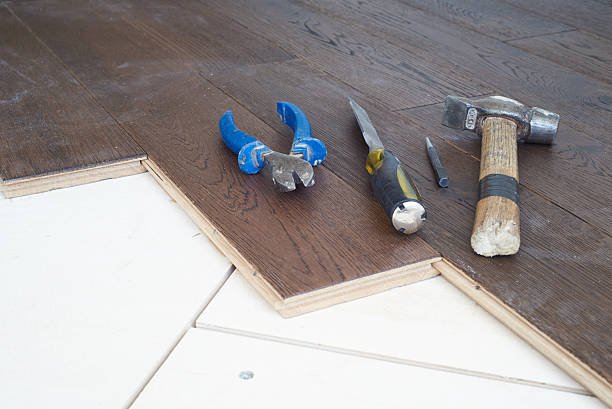
Owning an older home comes with a unique set of challenges, especially when it comes to maintenance and restoration. One of the most common issues homeowners face is unlevel floors. These uneven surfaces can detract from the home’s charm and make daily living uncomfortable. Fortunately, unlevel floor repair can not only restore the function of your floors but also enhance the overall appeal of your home. Let’s explore the causes of unlevel floors, their effects, and how you can effectively address the issue while maintaining the charm of your older home.
Understanding Unlevel Floors
Unlevel floors can be caused by various factors, many of which are inherent to older homes. One of the primary reasons is settling. As houses age, they may settle unevenly due to soil movement, moisture changes, or foundational issues. Additionally, the materials used in older homes—like wood—can warp, shrink, or expand over time, contributing to uneven flooring.
Another common culprit is water damage. Leaks from plumbing or roofing can cause wooden beams and joists to rot or warp, leading to unlevel surfaces. In some cases, the original construction may have been less than perfect, with improper framing or support. Recognizing the underlying cause of your unlevel floors is crucial for effective unlevel floor repair.
Effects of Unlevel Floors
Beyond aesthetics, unlevel floors can create significant issues in daily living. They can make it challenging to place furniture or appliances, leading to discomfort and frustration. In more severe cases, unlevel floors can cause structural problems, leading to further damage that may require extensive repairs.
Moreover, unlevel floors can indicate underlying issues with your home’s foundation. If left unaddressed, these issues can worsen over time, leading to costly repairs down the line. It’s essential to tackle unlevel floors not just for comfort but also to protect your investment in your home.
Assessing the Problem
Before diving into unlevel floor repair, a thorough assessment is necessary. Start by checking for signs of unevenness in different areas of your home. You can use a level tool to determine how unlevel your floors are. Pay attention to door frames and window sills; if these structures are leaning or sticking, it may be a sign of significant floor issues.
Next, inspect your foundation. Look for cracks or gaps, as these can indicate foundational problems contributing to your unlevel floors. If you’re uncomfortable conducting this inspection yourself, consider hiring a professional home inspector or structural engineer. They can provide a detailed evaluation of your home’s condition and recommend appropriate repair strategies.
Repairing Unlevel Floors
Once you’ve assessed the problem, it’s time to explore repair options. The method you choose will depend on the severity of the issue and the underlying cause.
- Shimming: For minor unlevel floors, shimming can be an effective solution. This involves placing thin pieces of wood or composite material under the affected areas to create a level surface. While this is a relatively straightforward process, it may only be a temporary fix if underlying structural issues are present.
- Sistering Joists: If the unlevel floors are due to weakened or damaged joists, sistering may be necessary. This involves adding a new joist alongside the existing one for added support. This method can be more invasive and may require lifting the floorboards, but it can significantly improve the structural integrity of your home.
- Mudjacking: If your floors are sagging due to soil erosion or shifting foundations, mudjacking (or slab jacking) may be an appropriate solution. This technique involves pumping a mixture of concrete and other materials beneath the foundation to raise it back to its original level. This approach is effective for addressing significant foundation issues but typically requires professional assistance.
- Replacing Floorboards: In cases where water damage or rot is severe, replacing the affected floorboards may be necessary. While this option can be more costly, it allows you to restore the charm of your older home by using materials that match the original style.
- Foundation Repair: If the unlevel floors are symptomatic of more extensive foundational problems, you may need to invest in foundation repair. This can involve a range of solutions, from installing piers or underpinning to stabilize the foundation to repairing cracks and leaks. Consulting with a foundation specialist is essential for understanding your options.
Restoring Charm After Repairs
Once the unlevel floor repair is complete, you can focus on restoring the charm of your older home. Here are a few tips to help you achieve that:
- Preserve Original Features: If possible, maintain original flooring materials, such as hardwood or vintage tiles. This will help keep the character of your home intact.
- Refinish Wood Floors: If you’ve repaired or replaced floorboards, consider refinishing the wood to enhance its beauty. Sanding and applying a new finish can breathe new life into your floors.
- Choose Appropriate Furnishings: When redecorating, opt for furnishings that complement the style of your older home. Vintage or antique pieces can enhance the charm and character of the space.
- Add Area Rugs: Area rugs can not only help level out your floors visually but also add warmth and texture to your rooms. Choose rugs that fit the aesthetic of your home while providing comfort underfoot.
- Incorporate Color and Light: Fresh paint and strategically placed lighting can help draw attention away from any remaining imperfections in your floors while brightening the space and making it feel more inviting.
Unlevel floors in older homes can be a challenge, but with the right approach to unlevel floor repair, you can restore their charm and functionality. Understanding the causes and effects of unlevel floors is crucial for effective repair. By assessing the situation, choosing the appropriate repair method, and focusing on restoration, you can not only improve the livability of your home but also preserve its unique character. Embrace the charm of your older home, and take the necessary steps to ensure that it remains a welcoming space for years to come.